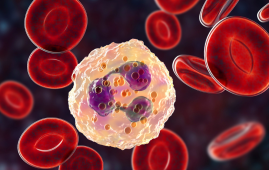

The range of options for treating cancer has increased as a result of research at Baylor College of Medicine and affiliated institutions discovering new therapeutic targets for the disease as well as fresh perspectives on already-identified cancer medication targets. The team identified protein and small protein or peptide targets in cancer tissues by using a comprehensive strategy that involved combining proteomics, genomes, and epigenomics data from 10 cancer types. Many of these targets were verified experimentally as viable candidates for therapeutic techniques. The research was published in Cell.
“Experience has shown that targeted therapies, cancer treatments directed at specific proteins in cancer cells, hold promise for achieving more effective clinical results than traditional radiotherapy and chemotherapy,” said co-corresponding author Dr. Bing Zhang, professor of molecular and human genetics and part of the Lester and Sue Smith Breast Center at Baylor. “Although there is progress identifying potential vulnerabilities of specific cancer types, fewer than 200 proteins are targeted by FDA-approved cancer drugs. In this study, we significantly expanded the list of potential therapeutic targets by analyzing data from more than 1,000 tissue samples spanning 10 cancer types.”
Utilizing computational instruments, the scientists combined proteogenomic data—which includes genome-wide details on DNA, RNA, and proteins—produced by the Clinical Proteomic Tumor Analysis Consortium (CPTAC) from prospectively gathered samples of primary tumors that had not yet received treatment, many of which had corresponding normal adjacent tissues for comparison. To identify potential targets for cancer therapy, the scientists combined the CPTAC dataset with other publicly available datasets and examined the similarities and differences between gene and protein changes detected in various tumor types.
“Our goal was to better understand the characteristics of known drug targets. We also hoped to identify new targets that could lead to new drug developments,” said Zhang, a McNair scholar and member of Baylor’s Dan L Duncan Comprehensive Cancer Center.
The group used the data integration technique to methodically pinpoint genes and proteins crucial to the formation and progression of cancer. Examples include the loss of tumor suppressor genes, which can lead to dependence on other proteins that may later be the subject of therapeutic intervention, and proteins that are overexpressed or hyperactive in cancer tissues but not in their normal counterparts. Additionally, they looked for tumor antigens, such as neoantigens, which are peptides unique to cancer that are produced when genes in tumors mutate.
“Our study revealed new opportunities for repurposing drugs currently approved for other conditions. For example, we show that an antifungal drug can also reduce the growth of several cancer types, supporting further exploration of the anti-cancer value of this drug.” – Dr. Bing Zhang, Professor, Molecular and Human Genetics, Baylor College of Medicine
The scientists also discovered putative protein targets that aren’t typically treated with medication; some of these targets are cell surface proteins, while others are kinase enzymes. “These findings open opportunities for drug development, including small-molecule drugs or drug-antibody conjugates,” Zhang said.
Moreover, the computational identification of multiple tumor-associated proteins that are common to various cancer types was succeeded by experimental validation of these proteins’ significance for cancer in laboratory-grown cells and animal models, thereby validating these proteins as promising therapeutic targets deserving of further investigation.
“I am very excited that we have created a comprehensive resource of protein targets, significantly expanding the therapeutic landscape by identifying many new candidates and covering various therapeutic modalities. And we have made our findings publicly available at https://targets.linkedomics.org,” Zhang said. “We hope that this resource will pave the way to repurposing currently available drugs and developing new therapies for cancer treatment.”
For more information: Pan-cancer proteogenomics expands the landscape of therapeutic targets, Cell, DOI:https://doi.org/10.1016/j.cell.2024.05.039
more recommended stories
 Urine-Based microRNA Aging Clock Predicts Biological Age
Urine-Based microRNA Aging Clock Predicts Biological AgeKey Takeaways (Quick Summary) Researchers developed.
 Circadian Control of Neutrophils in Myocardial Infarction
Circadian Control of Neutrophils in Myocardial InfarctionKey Takeaways for HCPs Neutrophil activity.
 E-Cigarette Use and Heart Attack Risk in Former Smokers
E-Cigarette Use and Heart Attack Risk in Former SmokersKey Takeaways for Clinicians and Nurses.
 36-Week Pre-eclampsia Screening May Reduce Term Risk
36-Week Pre-eclampsia Screening May Reduce Term RiskA New Preventive Strategy for Term.
 Cardiovascular Risk and Sudden Cardiac Death in Diabetes
Cardiovascular Risk and Sudden Cardiac Death in DiabetesRising Sudden Cardiac Death (SCD) Risk.
 Poor Kidney Function and Alzheimer’s Biomarkers Explained
Poor Kidney Function and Alzheimer’s Biomarkers ExplainedPoor kidney function may influence levels.
 Walking Speed Before Hip Replacement Predicts Recovery
Walking Speed Before Hip Replacement Predicts RecoveryNew Evidence Points to a Simple,.
 Neuroblastoma Drug Combo Extends Survival in Models
Neuroblastoma Drug Combo Extends Survival in ModelsA Promising Shift in High-Risk Neuroblastoma.
 How Soybean Oil Impacts Weight Gain and Metabolism
How Soybean Oil Impacts Weight Gain and MetabolismWhy Soybean Oil May Affect Metabolism.
 Coffee and Cognitive Function: Evidence Review
Coffee and Cognitive Function: Evidence ReviewA new narrative review in Cureus.

Leave a Comment